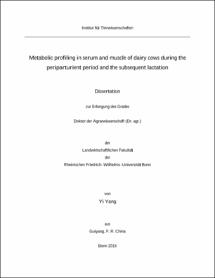Metabolic profiling in serum and muscle of dairy cows during the periparturient period and the subsequent lactation

Metabolic profiling in serum and muscle of dairy cows during the periparturient period and the subsequent lactation

| dc.contributor.advisor | Sauerwein, Helga | |
| dc.contributor.author | Yang, Yi | |
| dc.date.accessioned | 2020-04-24T16:15:40Z | |
| dc.date.available | 2020-04-24T16:15:40Z | |
| dc.date.issued | 17.12.2018 | |
| dc.identifier.uri | https://hdl.handle.net/20.500.11811/7389 | |
| dc.description.abstract | The transition period in dairy cows, spanning three weeks before and after parturition, is characterized by complex metabolic processes required for the homeorhetic adaptation to the needs of late pregnancy and the onset of lactation. Adaptive failure during the periparturient period may impair animal health and performance. Besides liver and systemic investigations performed in blood, the role of adipose tissue that is mostly affected by the mobilization of body reserves at that time, formed a research focus. Skeletal muscle is the largest organ in the body and is also involved in the adaptive reactions during the transition period, but alterations of metabolic pathways around parturition were scarcely characterized. Therefore, the aim of this dissertation was to characterize the metabolome in skeletal muscle and in serum of dairy cows during the transition from late pregnancy to early lactation. The oxidative capacity for fatty acids (FA) in skeletal muscle may also contribute to reducing the metabolic load of FA, and thus we took the profiles of muscle and blood serum FA esters of carnitine, i.e. the acylcarnitines (ACC) in focus. In addition, a dietary supplementation with conjugated linoleic acids (CLA) was tested for potential effects on the target variables. To achieve the objectives, a targeted metabolomics approach was used in which up to 188 endogenous metabolites from six different compound classes can be quantified. The ACC metabolism was further investigated by assessing the mRNA abundance of carnitine acyltransferases in muscle. Results of this study indicate that FA oxidation, as well as the metabolism of arginine, tryptophan, phosphatidylcholines, and sphingomyelines were the metabolic pathways that were mainly influenced by the transition from late gestation to early lactation. These altered metabolic pathways may reflect dysregulated lipid metabolism, impaired insulin action, and increased inflammatory status in dairy cows around parturition. Furthermore, when combining the results with the data from the mRNA abundance of carnitine acyltransferases, the results also indicate that β-oxidation in muscle mitochondria increased around parturition, but was likely exceeding the capacity of acetyl-CoA utilization in the tricarboxylic acid cycle. The present dissertation adds on to understanding the multifaceted metabolic adaptation of dairy cows during the transition from late pregnancy to early lactation. | en |
| dc.description.abstract | Die sogenannte Transitphase bei Milchkühen umfasst einen Zeitraum von rund drei Wochen vor und drei Wochen nach der Geburt. Sie ist durch komplexe Stoffwechselprozesse charakterisiert, die für die homörhetische Anpassung an die Bedürfnisse der Spätträchtigkeit und des Laktationsbeginns notwendig sind. Störungen in dieser Anpassung während der Transitperiode können die Gesundheit und Leistungsfähigkeit der Tiere beeinträchtigen. Neben in Leber und Blut durchgeführten Untersuchungen steht auch das Fettgewebe, das in dieser Zeit am stärksten für die Mobilisierung von Körperreserven zuständig ist, im Fokus der Forschung. Der Skelettmuskel ist das größte Organ des Körpers und ist ebenso an den Anpassungsreaktionen während der Übergangszeit beteiligt. Änderungen innerhalb der Stoffwechselwege rund um die Geburt, wurden hier aber bisher kaum beschrieben. Deshalb war es das Ziel dieser Dissertation, die Veränderungen im Metabolom des Skelettmuskels und des Serums von Milchkühen während der Transitphase zu beschreiben. Die Oxidation von Fettsäuren (FA) im Skelettmuskel kann auch dazu beitragen, die metabolische Belastung durch FA zu reduzieren, weswegen die Profile der FA-Cartinitin-Ester (ACC) in Muskulatur und Blutserum von besonderem Interesse waren. Der weiteren wurde eine Supplementierung der Futterration mit konjugierten Linolsäuren (CLA) auf mögliche Auswirkungen auf die Zielvariablen hin untersucht. Um diese Ziele zu erreichen, nutzten wir einen metabolomischen Ansatz ("targeted"), in dem bis zu 188 endogene Metaboliten aus sechs verschiedenen Stoffgruppen quantifiziert werden können. Der ACC-Metabolismus wurde zusätzlich durch die Bewertung der mRNA-Konzentration von Carnitin-Acyltransferasen in Muskelgewebe untersucht. Die Ergebnisse dieser Studie zeigen, dass die FA-Oxidation, sowie der Stoffwechsel von Arginin, Tryptophan, der Phosphatidylcholine und der Sphingomyeline hauptsächlich während der Übergangszeit von der späten Schwangerschaft bis zur frühen Laktation beeinflusst wurden. Diese veränderten Stoffwechselwege können an Dysregulationen im Fettstoffwechsel, der beeinträchtigte Insulinwirkung und dem erhöhten Entzündungsstatus bei Milchkühen um die Geburt beteiligt sein. In Kombination mit den RNA-Daten zeigt sich zudem, dass die β-Oxidation in den Muskelmitochondrien um die Geburt erhöht ist, aber die Kapazität der Acetyl-CoA-Nutzung im Tricarbonsäure -Zyklus wahrscheinlich überschritten ist. Die vorliegende Dissertation soll zum besseren Verständnis der vielschichtigen Stoffwechselanpassung von Milchkühen beim Übergang von der späten Trächtigkeit in die frühe Laktation beitragen. | en |
| dc.language.iso | eng | |
| dc.rights | In Copyright | |
| dc.rights.uri | http://rightsstatements.org/vocab/InC/1.0/ | |
| dc.subject | Dairy cow | |
| dc.subject | Metabolomics | |
| dc.subject | Early lactation | |
| dc.subject | skeletal muscle | |
| dc.subject | acylcarnitine | |
| dc.subject | carnitine shuttle | |
| dc.subject.ddc | 630 Landwirtschaft, Veterinärmedizin | |
| dc.title | Metabolic profiling in serum and muscle of dairy cows during the periparturient period and the subsequent lactation | |
| dc.type | Dissertation oder Habilitation | |
| dc.publisher.name | Universitäts- und Landesbibliothek Bonn | |
| dc.publisher.location | Bonn | |
| dc.rights.accessRights | openAccess | |
| dc.identifier.urn | https://nbn-resolving.org/urn:nbn:de:hbz:5n-52995 | |
| ulbbn.pubtype | Erstveröffentlichung | |
| ulbbnediss.affiliation.name | Rheinische Friedrich-Wilhelms-Universität Bonn | |
| ulbbnediss.affiliation.location | Bonn | |
| ulbbnediss.thesis.level | Dissertation | |
| ulbbnediss.dissID | 5299 | |
| ulbbnediss.date.accepted | 27.11.2018 | |
| ulbbnediss.institute | Landwirtschaftliche Fakultät : Institut für Tierwissenschaften (ITW) | |
| ulbbnediss.fakultaet | Landwirtschaftliche Fakultät | |
| dc.contributor.coReferee | Südekum, Karl-Heinz |
Dateien zu dieser Ressource
Das Dokument erscheint in:
-
E-Dissertationen (1120)




